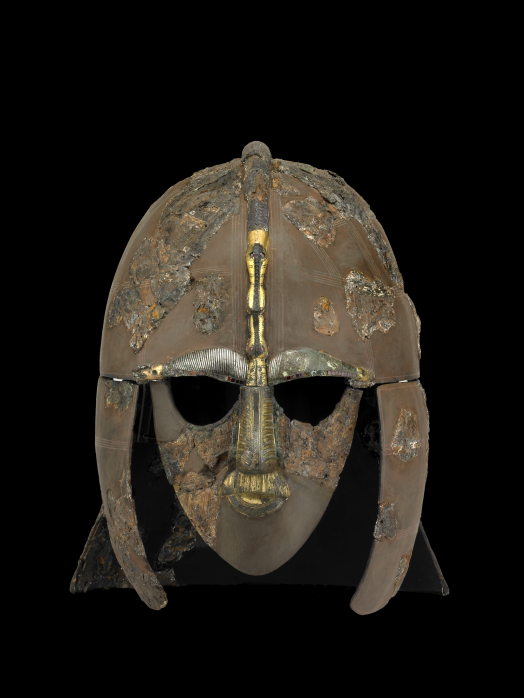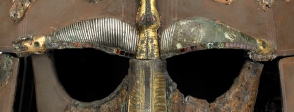
The burial place
The helmet was discovered in a large burial mound in the Anglo-Saxon kingdom of East Anglia. Many other objects were also found, including armour and weapons, silver dishes, musical instruments, feasting equipment such as a drinking horn and bottles, coins and fastenings for clothing. The mound, which has worn down over time, covered a ship that must have been dragged up several hundred metres from the river Deben. The presence of other mounds suggests this was a royal burial area, but the richness of this particular burial suggests it might have been that of a local ruler.
Ship burials indicate a relationship with the seafaring communities of Scandinavia, where other rich burials with ships have been found. Three others have been found in the UK so far, but none with such rich grave goods.
A symbol of power and wealth
In the period of continuity and change following the end of Roman rule in Britain, Anglo-Saxon rulers competed among themselves for supremacy. We know from Bede and other written sources that the royal family of East Anglia was embroiled in these conflicts. The objects in the burial referred to the role and status of the dead person, but also had a public message which would have been understood by the people assembled at the ritual of burial.
The mythological scenes on the helmet could be related to the pagan god Odin, Nordic god of war. In the Anglo-Saxon world, rulers needed to demonstrate that they could lead their people in war. Success in war meant maintaining stability and control, and perhaps expanding the kingdom. So objects such as the helmet were vital symbols of qualities of leadership.
The placing of valuable objects and materials in graves demonstrates the wealth and status of the dead person’s social group not merely through the objects and materials themselves, but through the group’s ability to dispose of and in effect destroy these goods.
This was a period when both pagan and Christian belief systems were being followed in East Anglia. The practice of ship burials and placement of objects within the burial space was a pagan practice. However, there are Christian symbols on several of the items.
Sutton Hoo changed ideas
The wealth of the burial and the quality of the objects had never been seen before in Britain and gave a vivid insight into the life of the Anglo-Saxon elite. It caused historians to re-assess the idea of a primitive Dark Age following the end of Roman rule and demonstrated that the Anglo-Saxons were capable of great sophistication and had a network of international contacts beyond Britain itself.
More information
Why is the helmet important?
A History of the World in 100 objects: listen to a useful summary of the importance of this object or read the transcript.
http://www.bbc.co.uk/ahistoryoftheworld/objects/kpnm6FD3TOaNri1gNPGJ1w
Burial overview
A very useful overview of the Sutton Hoo burial.
http://www.britishmuseum.org/explore/highlights/articles/k/the_sutton_hoo_ship-burial.aspx
Sutton Hoo: A history
Articles from National Trust on the site of Sutton Hoo and its history.
http://www.nationaltrust.org.uk/sutton-hoo/history/
Helmet restoration
The restoration of the Sutton Hoo helmet.
http://www.britishmuseum.org/explore/highlights/articles/r/restoration_sutton_hoo_helmet.aspx
BBC Masterpieces of the British Museum – part 1
Video on the story of the helmet’s excavation and detailed discussion of its meaning.
http://www.youtube.com/watch?v=T5yXQrTzUeg
BBC Masterpieces of the British Museum – part 2
Video on the story of the helmet’s excavation and detailed discussion of its meaning.
http://www.youtube.com/watch?v=oOgA4uy8qDI
The Sutton Hoo Helmet
Book by Sonja Marzinzik, The Sutton Hoo Helmet, British Museum Press, 2007.
http://www.britishmuseumshoponline.org/masterpieces/the-sutton-hoo-helmet/invt/cmc23257
More information
-
Why is the helmet important?
A History of the World in 100 objects: listen to a useful summary of the importance of this object or read the transcript.
Source: bbc.co.uk
-
Burial overview
A very useful overview of the Sutton Hoo burial.
Source: britishmuseum.org
-
Sutton Hoo: A history
Articles from National Trust on the site of Sutton Hoo and its history.
Source: nationaltrust.org.uk
-
Helmet restoration
The restoration of the Sutton Hoo helmet.
Source: britishmuseum.org
-
BBC Masterpieces of the British Museum – part 1
Video on the story of the helmet’s excavation and detailed discussion of its meaning.
Source: bbc.co.uk
-
BBC Masterpieces of the British Museum – part 2
Video on the story of the helmet’s excavation and detailed discussion of its meaning.
Source: bbc.co.uk
-
The Sutton Hoo Helmet
Book by Sonja Marzinzik, The Sutton Hoo Helmet, British Museum Press, 2007.
Source: britishmuseumshoponline.org


